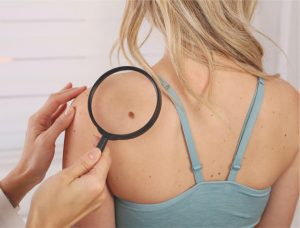Remember the most effective way to prevent the development of skin cancer is through an early examination by your Dermatologist.
Did you know that skin cancer is the most common form of cancer in both men and women in the U.S.?
 With an estimated 5 million new skin cancer cases diagnosed annually it far exceeds the total combined number of diagnoses of breast, prostate, lung and colon cancer. In fact, 1 in 5 Americans will be diagnosed with skin cancer by the age of 70. On average, one American dies every hour from skin cancer.
With an estimated 5 million new skin cancer cases diagnosed annually it far exceeds the total combined number of diagnoses of breast, prostate, lung and colon cancer. In fact, 1 in 5 Americans will be diagnosed with skin cancer by the age of 70. On average, one American dies every hour from skin cancer.
However, when caught early, skin cancer is highly treatable. Even melanoma, which is the most fatal form of skin cancer, has a cure rate of almost 100% when treated early.
7 Things You Need To Know About Skin Cancer
1. Sun Exposure increases the risk of skin cancer
Many people consider continuous sun exposure to be harmless because they believe the worst thing that can happen to them is sunburn, which heals after a couple of days. However, what most people don’t realize is that ultraviolet radiation (UV rays) from the sun adversely alters their skin cells and greatly increases the risk of cancer in the long run. The American Academy of Dermatology (AAD) recommends wearing protective clothing in the sun and using a sunscreen with a Sun Protection Factor (SPF) of 30 or higher.
2. Using sunscreen is not enough
Although applying sunscreen to your skin minimizes the negative effects of the sun, habitually using it doesn’t guarantee you won’t develop skin cancer. In fact, the sun is only one of the factors associated with developing skin cancer. In addition to UV rays, toxins, cigarettes and a poor diet could also contribute to the development of skin cancer.
5. An infection can cause skin cancer
Other possible causes of skin cancer are chronic injuries and swelling that occur from severe burns and infections. If the skin that protects the inner part of the body has a serious condition, the risk of developing malignant cells increases significantly.
6. Perform a skin self-exam for early detection
A skin self-exam can help you find skin cancer early when it is most treatable. Examine your body (front and back) in front of a mirror, looking at your elbows, forearms and the back of your upper arms. Closely check your feet, the spaces between your toes and your soles. Lastly, with a hand mirror scan your back, the back of your neck and your buttocks.
7. The “ABCDE” rule to identify skin cancer
The sudden appearance of brown spots on the skin and abnormalities in moles are the most obvious sign of possible skin cancer. However, there’s a method that can help you discern whether the moles or spots that appear on your skin are a cause for cancer.
A is for ASYMMETRY
If you draw a line down the middle of the mole, you will find that each half of a melanoma doesn’t match in size.
B is for BORDER
The edges of early Melanoma are quite likely to be irregular, crusty or notched.
C is for COLOR
Healthy moles are uniform in color. A variety of colors, especially black, white and/or blue is worrying.
D is for DIAMETER
Melanomas are usually larger in diameter than 6 millimeters, although they may be smaller.
E is for EVOLVING
When a mole begins to change in size, shape, color, or features or develops symptoms like itching, tenderness or bleeding, this points to danger.
What’s on YOUR Skin?
Contact SWFL Dermatology Plastic Surgery & Laser Center. Accepting most Florida & New York Insurance Plans including Florida Blue and GHI.
To improve the appearance and health of your skin, schedule a consultation today at SWFL Dermatology Plastic Surgery & Laser Center online or by phone at 239-500-SKIN.
SWFL Dermatology
(239) – 500-skin (7546)
SWFLDermatology.com
13800 Tamiami Trail N, Suite 112
Naples, FL 34110







